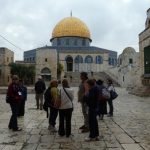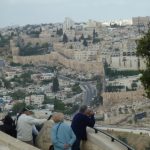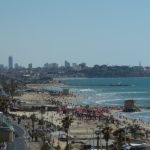‘Boker Tov’, good morning!
Our tour of Israel lasted for twelve days, and every day was packed with visits to historical sites; many recorded in the Bible. It was thrilling to stand in historical places which are so well documented, and to see many towns and cities thriving due to the influx of immigrants seeking a better life style. As an example, over one million Russian Jews have settled in Israel since the Union of Soviet Socialist Republics (USSR) was disbanded in 1991 under President Michael Gorbachev’s time in office. The present day population of Israel is close to 8,002,300 people.
Our holiday group flew from Hong Kong to Tel Aviv, on El Al, Israeli airlines, with our tour guides Ian and Mandy, both connected with United Christian Broadcasters (UCB), in conjunction with Olive Tree Travel agents.
As we flew in over the Mediterranean Sea, the city of Tel Aviv shone brightly in the morning sun. We could see why it is called the ‘White City’. The Bauhaus architectural style and white facades of over four thousand of the city’s buildings give the city a laundered appearance.
Tel Aviv has been built onto the northern side of Joppa, or Jaffa, as it is now known. Jaffa is reputed to be the oldest sea port in the world, and we found it buzzing with tourists, as we in our turn went to see the harbour, and the statue of a whale, significant to the story of Jonah.
From Tel Aviv, we drove north along the Mediterranean Coast, to Caesarea Maritima, the palace which Herod the Great built for himself, and where Roman governors, including Pontius Pilate were entertained on their visits to Israel, which was at that time, under Roman dominion. Excavations of a harbour, hippodrome, theatre, swimming pool, palace, and living quarters for the contingency of Roman soldiers, were all visible to us, offering fabulous photo opportunities. We saw part of the nine kilometre aqueduct, built to bring fresh water from the springs at the base of Mount Carmel to the palace community. At the time of its use, its flow was maintained purely by gravity. Herod the Great was well known for his engineering feats. He also engineered retaining walls along the shore line of Caesarea by transporting a special type of ash to each site. This he packed into square crates, and then sunk these crates into their positions under the sea. The sea water then permeated the ash, and the ash hardened into a type of concrete, fulfilling its purpose.
Visible to the south of Caesarea Maritima is a large coal fired power station, with its own coal wharf. The power station helps provide power to run the world’s largest desalination plant situated within Israel.
Moving further north, we ascended Mount Carmel, to view the Mediterranean Sea to the west, the Valley of Jezreel also named The Valley of Megiddo to the east, and Lebanon to the north.
Israel has a low annual rainfall, and because of this the nation has become a world leader in successful agricultural methods, of most significance, the ‘Netafim’ irrigation system, which is an underground drip method. Deserts have bloomed into farmlands, and there is an abundance of produce to be seen at nearly every turn in the road. Israel provides for its own fruit and vegetable needs, and is also a major exporter of these to Europe, along with flowers of many kinds.
On our way to the Sea of Galilee, which is also called the Lake of Gennesaret, we visited the city of Nazareth, where Jesus grew up; no longer a small town, but an impressive community built on the hillsides, and an obvious major tourist venue, which brings added industry for the local Arab and Jewish population.
During our three day sojourn in the Galilee area, we visited the Golan Heights, and stood near the borders of Lebanon and Syria. On a clear day, Damascus can be seen in the distance. We walked through the underground passages of the Israel Defence Force watch towers which had been operational during the Syrian/Israeli conflict of 1967. There are still many live land mines which were planted by the Syrian army during their occupation, thereby making it unsafe to traverse outside of the designated walking areas.
On one of our days, we circumnavigated the Sea of Galilee, and saw where the River Jordan begins its flow from the base of the snow capped Mount Hermon. We took a boat ride on the lake, saw a two thousand year old fishing boat in its museum near Capernaum, and visited a diamond cutting factory at Tiberius. Because of superior quality craftsmanship, sixty percent of the world’s diamonds from De Beers Diamond Centre in London are sent to Israel for cutting and polishing. Skill lies in the high number of facets cut onto the diamond face, thus making each diamond sparkle all the more. Of course, there was a jewellery shop right next door, for those with spare cash to spend!
The Dead Sea was our next stopover. We arrived at an oasis of high rise hotels, where people from every nation resort to, while they float in the health restorative salt water, which is eight point seven times saltier than normal sea water. There are twenty one different minerals extracted from the Dead Sea. The sale of these in all of their forms, adds greatly to the economy of Israel.
Travelling along the Jordan River Valley, we took in all of the historical sites along the way. I was particularly impressed with the mountainous terrain along both sides of the valley, especially the Judean Hills to the south west. The cable car ride to another one of Herod the Great’s engineering marvels, Masada, was one of the trip’s highlights. This ‘holiday retreat’ was built on top of a most inaccessible rocky plateau, and served not only as a palace, but also later on in history, as a final retreat and fortress for a group of Jewish zealots who fought to the death against their Roman oppressors.
On our way to Jerusalem, we stopped to view the Qumran Caves, where the Dead Sea Scrolls were discovered in 1947 and which are now on display in the Israel Museum Shrine of The Book.
Jerusalem is called The Holy City, and is sacred to Jews, Moslems, and Christians alike. There is so much to see, including; The Dome of The Rock, The Wailing Wall, the Mount of Olives, the Garden of Gethsemane, Calvary, The Garden Tomb, King Hezekiah’s Water Tunnel, Yad Vashem- the Holocaust Memorial, and Mount Scopus, where our ANZACS are laid to rest.
What stood out to me visually, were the acres and acres of white tombstones in the cemeteries covering the hillsides of the Mount of Olives. This is where Jews of the faith choose to be laid to rest, so that they will be near to where ‘Messiah’ will return one day.
Today, there are thousands upon thousands of tourist groups coming from the nations of the world to see for themselves things and places they have only read and heard of! In these times of continuous border warfare, this tiny nation of Israel is prospering. I was privileged to see it for myself.
‘Shalom’
Prepared by Heather Irons, RN TMA Yeppoon


